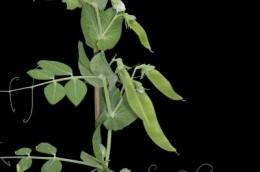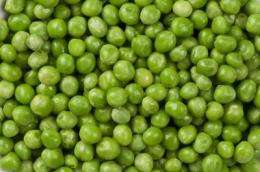Perfect peas to push profits and cut carbon

Scientists, pea breeders and the food industry are collaborating to discover how taste and tenderness can be determined by biochemistry and genetics. They will work together to hone the make-up of a perfect pea.
In a £1.5M, 3.5-year project coordinated from the John Innes Centre, the project partners will find new ways to develop improved pea varieties for the high profit margin food market. They will also study the likely impact of greater uptake of legume farming on nitrogen fertiliser use.
"High quality peas will fetch a high price in the food market," says Dr Claire Domoney from the John Innes Centre, an institute of the BBSRC. "If more farmers can be encouraged to grow these as a rotation crop we can reduce the carbon footprint of UK agriculture by reducing the amount of nitrogen fertiliser needed."

Most crops require additional nitrogen. Fertilisers can increase yield by as much as 50%, but producing them uses more fossil fuels than any other agricultural process. They also cause pollution when they leach into groundwater and the atmosphere. Nitrous oxide, a greenhouse gas 300 times more potent than CO2, is produced by agriculture from the use of these fertilisers and this contributes about 12% of European greenhouse gas emissions.
Legumes such as peas are able to take nitrogen from the air and replenish soil levels. But farming legumes is not as popular as it could be. This is partly because profit margins in the easier to access feed market are relatively low. Food crops have a much higher value but quality must be very high. Sustaining quality will ensure better markets for farmers and so contribute positively to the environmental impact of agriculture.
This project will identify the determinants of quality in peas by studying the interaction of genetics and metabolites with important retail traits such as taste and tenderness. The aim is to develop superior lines that will create new markets, drive up profit margins for farmers and increase the uptake of legume farming. The research will also establish new methods for assessing maturity in the field, and may be applied to other food crops.

The LINK project is funded jointly by the Biotechnology and Biological Sciences Research Council (BBSRC) and Defra. Partners include the Food and Environment Research Agency (Fera), the Processors and Growers Research Organisation (PGRO) and Campden BRI, with commercial input from Bird's Eye, The Co-operative, Limagrain, Thermo Fisher Scientific, Premier Foods, Pinguin Foods and the Horticultural Development Company (HDC).
Provided by Norwich BioScience Institutes
















